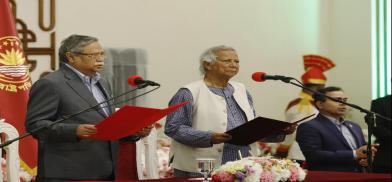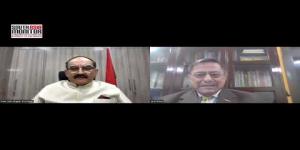Challenges in building a new Bangladesh: Yunus has his work cut out
India offered unqualified support to Hasina over the last decade or so. For India, it will be a major challenge to see how it builds a relationship when a new democratic government emerges in Bangladesh. China had invested more in infrastructure in Bangladesh in the last decade or so; and the relationship was improving. But it did not interfere in domestic political issues.

The Awami League-led Sheikh Hasina government won a landslide victory in the 2008 election and was widely applauded by the people. However, the moral values and spirit of the 1971 liberation war were soon drowned in corruption and nepotism. Oppression onopposition political parties, attacks on civil society, and capturing media to oppress freedom of expression were some of the characteristics of her government.
The caretaker government system was abolished, which was responsible for holding fair elections. Then elections became just an orchestration of winning every election through rigging. Hasina continued to rule with absolute power through one unacceptable election after another. She then began to govern the country single-handedly by putting corrupt executives in state departments. Ultimately the result was “absolute power corrupts absolutely.”
Her government gradually subjugated almost every department of the state in exchange for huge unaccountable privileges: the military, the police force, the bureaucracy, and to a large extent the judiciary. The country has been turned into an empire of unstoppable plunder by allowing lakhs of party workers to engage in indiscriminate terror and looting. Thanks to social media virality, in her last period, many massive corruption stories emerged, which wreaked her legitimacy.
Hasina's authoritarian turn
Scholars warned years ago about the authoritarian turn of Sheikh Hasina. A major characteristic of her government and political culture was oppressing any opposing opinion that was tagged ‘Rajakar'—traitor of the country. Even those scholars who criticized the actions of this government were attacked and labeled ‘anti-Bangladeshi’.
Hasina has also sidelined many experienced and committed Awami League leaders, such as Matia Chowdhury, Tofail Ahmed, and Quader Siddiqui, and did not receive advice from many intellectuals who were long-standing supporters of Sheikh Mujib and his moral political principles. She was surrounded by corrupt ministers and advisors who would not tolerate any constructive criticism. It was in this context that the students started a movement against the discriminatory quota reform.
Political observers who followed this development closely contend that Sheikh Hasina became overconfident and ignored all kinds of advice. Too totalitarian in the end she may have perpetrated killings that could have resulted in about 500 deaths between July 16 and August 5.
Student protests turned into a mass movement ending 15 years of Sheikh Hasina's rule and bringing the country to a new juncture. This student protests initially began as an anti-discrimination protest with a demand for fair job opportunities in civil service jobs, to removing around 56% of the quota system, with a majority portion of 30% for veterans and their children.
Although the initially peaceful protest could have been better handled, Hasina was so arrogant she even called the students "descendants of Rajakars" which was a huge insult that sparked fire in students. When Abu Sayed, a student leader, was fired upon, it sparked a wider protest that inflamed the masses, from a rickshaw puller to a labor worker, from mothers to sisters.
Weeks of intense turmoil then turned into one demand protest - resignation of Sheikh Hasina- ending with a bloody battle against the police force and the mob by the student wing of the ruling party. Students then became more defiant, showing unfathomable courage fto fight for their rights. They broke the curfew and overcame fear of the army. In symbolizing the blood of their fellow students, they started to paint red. This red color then sparked a revolution not only on the streets of the cities and towns in the country but also on the digital plane, spreading all around the world wherever Bangladeshis supported this mass movement.
Student-led people's rebellion in Bengali history has few remarkable legacies defying any subjugation. The 1952 language movement, 1970 mass uprising, Liberation War of 1971, and 1990s mass uprising are proof of this.
However, the unspeakable brutality that was done to the unarmed students and common people by the armed student wing of the Awami League, police, Border Guards Bangladesh and military forces— killings, deaths, arrests, and tortures—is one of the saddest chapters in the history of the Bengali-speaking nation.
Turning point for Hasina
Hasina's totalitarian actions destroyed her legitimacy and moral standing. In the last hours, she asked heads of defense to stop the students. However, the only way the mass anger could have been stopped was by open firing on the civil protests, which the army rejected.
In the afternoon of August 5, when the student-led march broke all the barricades, curfew, and army and marched towards the Gonobhaban (official residence of the Prime Minister), the army informed Sheikh Hasina that the students were only 45 minutes away. Hasina had only time to officially resign and take the army-lent helicopter to flee the country.
Her arrogance and totalitarian actions created a suffocating condition for the country, where she herself could not breathe. For the students, a breath of fresh air was toppling of her government, and for her, the escape was a way to save possibly her life and dignity. However, the spark that she ignited burned the offices of the Awami League and the historical landmark, 32 Dhanmondi, the Sheikh Mujib Memorial Residence. The country faced more riots and violence in the wake of her fall. Many policemen were killed and police stations were burned.
Students mandated Dr. Muhammad Yunus to lead the interim government. First and foremost, he is a deeply respected intellectual and civil society leader nationally and internationally; secondly, he has proven to be a worthy person by staying on his values and principles, despite facing all the political oppressions from Sheikh Hasina. But despite all the struggles, he never gave up his fight for justice and for his principles. Most importantly, he has not been involved in any party politics so far. So in this realm, he appeared to be the best option for the students who have been seeking a new beginning for the country.
India offered unqualified support to Hasina over the last decade or so. For India, it will be a major challenge to see how it builds a relationship when a new democratic government emerges in Bangladesh. China had invested more in infrastructure in Bangladesh in the last decade or so; and the relationship was improving. But it did not interfere in domestic political issues. On the other hand, many believe that the US administration will be closer to new dispensation.
Who is Muhammad Yunus and what challenges are ahead of him?: Muhammad Yunus, 84, born in Chattogram, was an economics professor at Chittagong University, known as the "banker to the poor." Yunus founded the Grameen Bank in 1983, which significantly helped alleviate poverty in Bangladesh in housing, student, and micro-enterprise loans, particularly supporting Bangladeshi women. He won the 2006 Nobel Peace Prize for pioneering microfinance.
Yunus has been a longtime critic of Hasina, who accused him of exploiting the poor. In 2011, Yunus was removed as managing director of Grameen Bank by the government-controlled central bank, allegedly for exceeding the retirement age. Yunus faced multiple legal cases during Hasina's tenure, which he and his supporters claimed were politically motivated.
Tasks for Yunus
It is too early to measure what change he can bring in the near future. Taking the historic step to lead a new Bangladesh in this critical juncture, his immediate challenges are, however -
re-establishing law and order after violent protests that left so many deaths;
- addressing the deep public mistrust and building democratic institutions such as police, judiciary, and other state institutions;
- organizing free and fair elections, which were a major demand of the protest movement.
Yunus will face pressure to initiate judicial procedures addressing human rights violations committed in recent weeks and during Hasina's rule. Ensuring justice for the hundreds of innocent lives lost during the protests will be crucial to maintaining the support of the student movement.
Utilizing his economic expertise, Yunus will need to focus on economic reforms vital for combating corruption and fostering national growth. Yunus may encounter resistance from supporters of Hasina within the state departments, particularly in the judiciary and law enforcement sectors.
The message from the protests that rocked Bangladesh and the sacrifices of so many students is that the new Bangladesh seeks to build a society that upholds democratic values where differing opinions could be expressed without fear.
(The author holds a PhD in political science from Heidelberg University, Germany. Views are personal. He can be contacted at meahmostafiz@gmail.com)










Post a Comment